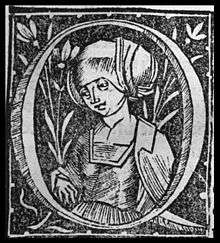Paul of Aegina
Paul of Aegina or Paulus Aegineta (Greek: Παῦλος Αἰγινήτης; Aegina, c. 625 – c. 690) was a 7th-century Byzantine Greek physician best known for writing the medical encyclopedia Medical Compendium in Seven Books. "He is the father of early medical books". For many years in the Byzantine Empire, this work contained the sum of all Western medical knowledge and was unrivaled in its accuracy and completeness.

Life
Nothing is known about his life, except that he was born in the island of Aegina, and that he travelled a good deal, visiting, among other places, Alexandria.[1] He is sometimes called Iatrosophistes and Periodeutes, a word which probably means a physician who travelled from place to place in the exercise of his profession. The exact time when he lived is not known; but, as he quotes Alexander of Tralles,[2] and is himself quoted by Yahya ibn Sarafyun (Serapion the Elder),[3] it is probable that Abu-al-Faraj is correct in placing him in the latter half of the 7th century.[4]
Works
The Suda says he wrote several medical works, of which the principal one is still extant, with no exact title, but is commonly called Medical Compendium in Seven Books (Greek: Ἐπιτομῆς Ἰατρικῆς βιβλία ἑπτά, Epitomes iatrikes biblia hepta). (Digital German edition by the University and State Library Düsseldorf) This work is chiefly a compilation from earlier writers;[5] indeed its Greek title proclaims that it is an epitome of medicine, "epitomes iatrikes."
William Alexander Greenhill wrote that his reputation in the Islamic world seems to have been very great, and it is said that he was especially consulted by midwives, whence he received the name of Al-kawabeli or "the Accoucheur."[6] He is said by the Arabic writers to have written a work, "De Mulierum Morbis," and another, "De Puerulorum Vivendi Ratione atque Curatione." His great work was translated into Arabic by Hunayn ibn Ishaq.[6]
The sixth book on surgery in particular was referenced in Europe and the Arab world throughout the Middle Ages,[7] and is of special interest for surgical history. The whole work in the original Greek was published in Venice in 1528, and another edition appeared in Basel in 1538. Several Latin translations were published.[8] Its first full translation into English, was by Francis Adams in 1834.[9]
In this work he describes the operation to fix a hernia similar to modern techniques writing, "After making the incision to the extent of three fingers' breadth transversely across the tumor to the groin, and removing the membranes and fat, and the peritoneum being exposed in the middle where it is raised up to a point, let the knob of the probe be applied by which the intestines will be pressed deep down. The prominence, then, of the peritoneum, formed on each side of the knob of the probe, are to be joined together by sutures, and then we extract the probe, neither cutting the peritoneum nor removing the testicle, nor anything else, but curing it with applications used for fresh wounds." [10]
Notes
- Smith 1867, p. 152 cites: Paul of Aegina, iv. 49, p. 526
- Smith 1867, p. 152 cites: Paul of Aegina, iii. 28, 78, pp. 447, 495, vii. 5, 11, 19, pp. 650, 660, 687
- Smith 1867, p. 152 cites: Ibn Sarafyun, Pract. vii. 9, pp. 73, 74, ed. Lugd. 1525
- Smith 1867, p. 152 cites: Abu-al-Faraj, Hist. Dynast. p. 114.
- Smith 1867, p. 152.
- Smith 1867, p. 153.
- Pormann 2004.
-

- (Aegineta.) 1834, p. v (The Editor's Prefix).
- Aegineta, Paulus (1921–24). Medical Epitome. Leipzig and Berlin: Heiberg. pp. 9–17.
References
- (Aegineta.), Paulus (1834). Adams, Francis (ed.). The Medical Works of Paulus Aegineta, the Greek Physician: Tr. Into English; with a Copious Commentary Containing a Comprehensive View of the Knowledge Possessed by the Greeks, Romans, and Arabians, on All Subjects Connected with Medicine and Surgery. 1 (First ed.). Welsh, Treuttel, Würtz.CS1 maint: ref=harv (link) (), Paulus (Aegineta; Adams, Francis (1834). The Medical Works of Paulus Aegineta, the Greek Physician: Tr. Into English; with a Copious Commentary Containing a Comprehensive View of the Knowledge Possessed by the Greeks, Romans, and Arabians, on All Subjects Connected with Medicine and Surgery.CS1 maint: numeric names: authors list (link))
- Keyser, Paul T.; Irby-Massie, Georgia L. (2012-11-12). Encyclopedia of Ancient Natural Scientists: The Greek Tradition and its Many Heirs. Routledge. ISBN 9781134298020. Retrieved 19 October 2013.
- Pormann, Peter E. (2004). The Oriental Tradition of Paul of Aegina's Pragmateia. BRILL. ISBN 9789004137578. Retrieved 1 December 2012.
- al-Zahrāwī, Abū al-Qāsim Khalaf ibn ʻAbbās (1973). مقالة في العمل باليد: A Definitive Edition of the Arabic Text. University of California Press. ISBN 9780520015326. Retrieved 1 December 2012.

Further reading
- (Aegineta.), Paulus (1844). Adams, Francis (ed.). The seven books of Paulus Ægineta (in 3 volumes). 1 (Second ed.). Printed for the Sydenham Society. (), Paulus (Aegineta (1844). The Seven Books of Paulus Ægineta.CS1 maint: numeric names: authors list (link))
- (Aegineta.), Paulus (1846). Adams, Francis (ed.). The seven books of Paulus Ægineta. 2 (Second ed.). Printed for the Sydenham Society. (), Paulus (Aegineta; Adams, Francis (1846). The Seven Books of Paulus Ægineta.CS1 maint: numeric names: authors list (link))
- (Aegineta.), Paulus (1847). Adams, Francis (ed.). The seven books of Paulus Ægineta. 3 (Second ed.). Printed for the Sydenham Society. (Paulus, Aegineta (1847). The Seven Books of Paulus Aegineta: Translated from the Greek. With a Commentary Embracing a Complete View of the Knowledge Possessed by the Greeks, Romans, and Arabians on All Subjects Connected with Medicine and Surgery by Francis Adams. III.)
- Heiberg, Johan Ludvig, ed. (1921–1924). "Heiberg's CMG' Greek text (Index entry IX)". The Berlin-Brandenburg Academy of Sciences and Humanities. Retrieved May 2012. Check date values in:
|accessdate=(help); External link in|publisher=(help) - Savage-Smith, Emilie (7 December 2011) [2004]. "Islamic Medical Manuscripts at the National Library of Medicine: Bio-Bibliographies: Paul of Aegina". U.S. National Library of Medicine.